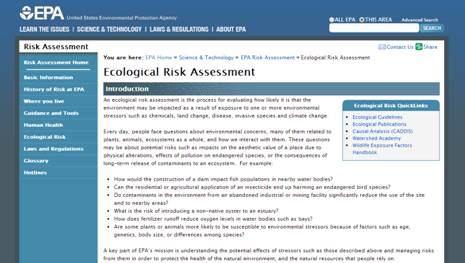Risk management and assessment
When risk characterization is complete, a description of the risk assessment is communicated to the risk manager (fig. 1) to support a risk management decision. This communication usually is a report and, for example, might include a description of risk assessor/risk manager planning results. The discussions between risk assessors, risk managers and also stakeholders are emphasized both at risk assessment initiation (planning) (e.g. discussions about how to proceed so the results of the assessment will be most useful to those who will have to use them) and completion (communicating results) (fig. 1). These discussions are essential to strive for a continuous improvement in understanding the ecosystem and providing optimum functionality. Additionally, a clear distinction is usually drawn between:
- Risk assessment - focuses on scientifically evaluating the likelihood of adverse effects.
- Risk management - involves the selection of a course of action in response to an identified risk that is based on many factors (e.g.: legal, social, or economic) in addition to the risk assessment results.
Monitoring and other data acquisition is often necessary during any phase of the risk assessment process, and the entire process is typically iterative rather than linear (fig. 1). The evaluation of new data or information may require revisiting a part of the process or conducting a new assessment.
Final note: Ecological risk assessment is vital for environmental decision making due to the high cost of eliminating environmental risks associated with human activities and the necessity of making regulatory decisions in the face of uncertainty. This process provides only a portion of the information required to make risk management decisions. However, this information is critical to a scientifically secure risk management. Therefore, ecological risk assessment should provide input to a diverse set of environmental decision-making processes, such as the regulation of hazardous waste sites, industrial chemicals, and pesticides, or the management of watersheds affected by multiple chemical and nonchemical stressors.
More detailed explanations of
the applications of ecological risk assessment process can be found in
the following book and links:

Suter GW II. (2007). Ecological Risk Assessment. 2nd edition. CRC Press, Boca Raton, FL. 643p.
http://www.epa.gov/risk_assessment/ecological-risk.htm
Question - Ecological risk assessment:
1. Compare two sites with identical contamination of DDT in surface water and sediments. At one site, the surface water and sediments are part of a recreational fishing area (e.g., a lake stocked with trout). At the other site, the surface water and sediments are not used for recreational purposes, but a protected raptorial bird known as an osprey hunts fish in the mountain lake that is impacted.
WHAT ARE THE MANAGEMENT GOALS IN THESE BOTH CASES?
Response:
In the first example, our goal would most likely be to protect the trout population in the lake. The ecological value of the lake community is primarily associated with the sport recreational use by humans. Therefore, we would manage this site to protect this resource.
Note: Although the individual trout might be affected, this would be acceptable as long as the entire population is not affected.
For the second example, the goal would be to protect individual ospreys from eating fish contaminated by chemicals in the surface water and sediments. Because the osprey is a protected species, we need to manage effects at the individual level in a risk assessment.
Final note: Identifying what is of value and what needs to be protected is a critical, complex, and sometimes controversial process in an ecological risk assessment.
